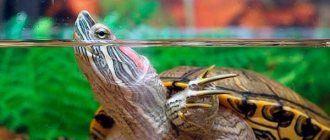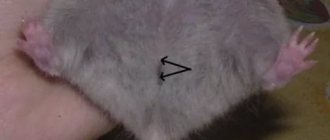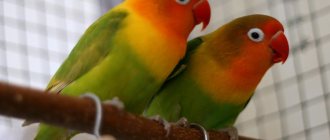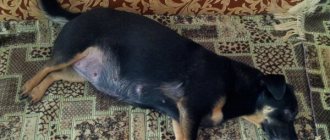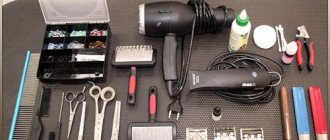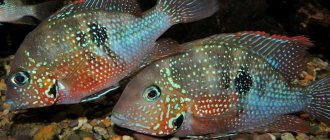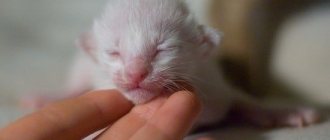All about lovebirds
These are flocking birds, however, they are aggressive towards birds of other species and can even attack an individual much larger than themselves. They settle near bodies of water. They sleep in trees, clinging to small twigs with their paws so as not to fall. They eat directly from the branch and do not take food into their paws. They often raid fruit plantations and destroy agricultural plantations. Excellent and they fly a lot. They nest in hollows, empty holes, under roof canopies and in the walls of residential buildings.
Appearance
Lovebirds are small birds with a body length varying depending on the variety and gender from 10 to 17 cm and weighing about 50 grams. The length of the parrot's wing is only 4 cm, and the tail, rounded at the end, is 6 cm. The lovebird has disproportionately short legs relative to the body and a large head. Birds have a powerful curved beak.
Important! In lovebirds, the main feather color is determined by two pairs of unlinked non-allelic genes. This means that in addition to the common green one, you can find white, blue, and yellow parrots.
Types of lovebirds with photos
Lovebirds are divided into 9 subspecies, each of which has its own distinctive features, primarily related to the description of external data.
- Collared (Agapornis swindernianus) - body length 13 cm. A distinctive feature is a collar in the form of an orange thin stripe on a dark neck. The beak is almost black. The breast has a yellowish tint, and the plumage under the tail is blue.
- Masked (Agapornis personatus) - body length 15 cm. The predominant color of the plumage is orange-yellow, but the tail, back, abdomen and wings are green. The beak stands out as a red spot on the brown-black head.
- Red-faced (Agapornis pullarius) - body length 15 cm. Males are green, females have greenish-yellow shades in their plumage. The frontal area, cheeks and throat are colored rich orange-red. Females have a completely orange head.
- Rosy-cheeked (Agapornis roseicollis) - body length 17 cm, while males are smaller than females, but their color is many times more intense. The parrot is olive in color with a bluish tint. The pink on the bird's cheeks and throat gradually turns into deep red on the forehead. The beak is straw-colored.
- Black-cheeked (Agapornis nigrigenis) - body length 14 cm. Similar to masked lovebirds with a difference in the color of the head - it has a grayish tint. An orange-pinkish color is present in the plumage of the upper half of the breast and gradually turns green downwards.
- Blackwings (Agapornis taranta) - body length from 17 cm or more (the largest of the lovebirds). The bird is bottle green in color. The frontal region, eye rims and beak are bright scarlet. The wings are outlined with a black border.
- Grey-headed (Agapornis canus) - body length 14 cm. Green parrot. Starting from the head to the middle of the chest, the color of the male’s plumage is light gray, almost white. In the female, this area is colored grayish-green.
- Lilianas (Agapornis lilianae) - body length 15 cm. They are similar to pink-cheeked lovebirds with the only difference that the head and neck have a more saturated color. The back and wings of the parrot are much darker than the belly and chest. The bird's beak is bright red.
- Fischer's lovebirds (Agapornis fischeri) - body length maximum 15 cm. Yellowish-green parrot with bright golden-orange coloring of the head and neck with brownish splashes. The tail feathers have a blue tint at the end. The beak is red.
Collared
Masked
Red faces
Rosy-cheeked
Black-cheeked
Blackwings
Grey-headed
Liliana's lovebird
Fisher's lovebirds
Lovebirds - why they were called that
It is no coincidence that the birds were called lovebirds. It has long been believed that the male lovebird parrot is monogamous and chooses a mate for himself once and for the rest of his life. If one of the parrots dies, then soon, unable to bear the separation, the other will follow him out of sadness. In practice, everything is different; an orphaned bird can easily build a relationship with a new feathered partner.
Parrot selection
This species can live in flocks, pairs and alone. If the future owner wants only one bird, it is advisable to prefer one born in captivity and already domesticated.
How to choose a parrot
In other cases, she will yearn for communication. You need to choose a couple from one representative at a time from different breeders, so that no excesses occur in the offspring due to family ties.
Natural habitats
Depending on the species, lovebirds inhabit the forests of the tropics and subtropics; some species prefer mountainous areas and steppe plains.
Geographically, lovebirds live in the southeast, southwest and central Africa, and to be more precise:
- collared - in central Africa and the southwest of the continent;
- masked - in Kenya and on the east African coast in Tanzania;
- red-faced - in Ethiopia, Tanzania, Sao Tome, Sierra Leone;
- rosy-cheeked - in South Africa, Namibia and Angola;
- black-cheeked - in the southwest of Zambia;
- black-winged - in Ethiopian forests and mountains, as well as in northeast Africa;
- grey-headed - on the islands of Madagascar, Zanzibar, Mauritius, in the Seychelles in palm and date plantations;
- Liliana's lovebirds - in the eastern district of Zambia, southern Tanzania and northern Mozambique;
- Fisher's lovebirds - in northern Tanzania.
How to care for your pet
Attention from the owner must be constant. At first, the birds are afraid of new acquaintances, shy away from hands and sit in their cage forever. This is temporary.
If there is a lot of emotional involvement in the new family member, the parrot will make contact sooner and will stop hiding in a corner when people appear. Doors must always be open.
Subsequently, the birds will freely stretch their wings, flying around the room, which is very useful and helps to avoid many diseases.
How to properly care for a parrot
Proper diet: what you can and cannot eat
Grain mixtures are the basis of nutrition, but there is one caveat. Wavy food is not suitable for a pair of lovebirds. Need food for medium parrots. The grain must be sifted. In addition to the base, various additives are required:
- vegetables (carrots, cauliflower, broccoli, radishes, turnips and the like);
- fruits (bananas, peaches, kiwi, cherries, apricots, plums, tangerines (all pitted);
- rowan, cucumbers, peanuts, walnuts.
It is very useful to give oats and millet sprouted. In our latitudes, tropical residents adore the dandelion leaf.
The daily intake of food is two to three teaspoons for each person.
You should not offer parrots lemon slices, although the water is enriched with a couple of drops of juice to prevent infections. For them, bird cherry is a potent poison; the seeds contain hydrocyanic acid. This dose does not harm people, but kills birds.
What to feed a lovebird
Cleaning the cage
In the morning or evening, you need to wash the tray, feeders and drinkers with a sponge under hot water without chemical detergents. Once a week, wash the entire bottom, wipe the poles, rods, and toys with a damp cloth.
Every month you need to disinfect everything with a decoction of calendula or chamomile, you can use a weak solution of manganese. This helps get rid of germs, bacteria, even parasites.
Read also
How to wash a parrot's cage
Bathing
Bathing is a great pleasure for lovebirds. You need a suitable bath, otherwise they will dive into the drinking bowl and into any other containers in which they find liquid.
Bird games and training
Parrots are more likely to learn to pronounce sounds from a child or woman with a high-pitched voice. To do this, devote ten minutes to exercise every day before feeding. The thin voice is mesmerizing.
The lesson should be more like a normal conversation; you shouldn’t get angry and stubbornly demand anything. The parrot will not immediately repeat the whole phrase. You need to start with individual sounds and short words.
You should always fill what is said with emotion and try to maintain intonation. Many people use a voice recorder and other aids. However, communication with a living person is much more pleasant for birds and brings more results.
Vaccination
The vaccination is almost always combined, capable of eliminating rabies, adenovirus, psittacosis, parainfluenza virus, and sometimes leptospirosis.
It is given once, then on a schedule every three or four weeks until a certain age. Before six months of age, it is mandatory to be vaccinated against rabies.
Diseases and prevention
Basically, lovebirds rarely get sick because they are removed from the outside world. However, it happens. Diseases can be divided into three classes:
- Non-contagious (injuries, vitamin deficiency, obesity, improper molting, problems with egg laying, swelling of the joints, etc.).
- Parasitic diseases affecting the food tract, skin, eyes, paws, beak, down and feathers. They are caused by helminths and various mites.
- Contagious when you urgently need to stop contact with relatives.
Read also
Diseases of lovebirds and their symptoms
In any case, an ornithologist is needed immediately as soon as the first symptoms are noticed. Prevention requires only careful care, proper diet and hygiene.
Sleep and rest
Birds sleep at least ten hours every day, and in winter, up to fourteen. They fall asleep at dusk. Therefore, in the summer you can create the onset of night artificially, thus helping the birds to rest. Sometimes during the day they settle down on their perch, legs tucked under, to take a nap. There is no need to interfere with them, there is also nothing to worry about.
Character and abilities
The lovebird adapts well to new conditions, quickly gets used to people, and is devoted to its owner. Shy, may die from a broken heart. At the same time, he is curious and cocky. Has a good memory and high intelligence. Finds its cage, responds to its name, and can be trained.
Those who have ever heard lovebirds sing are concerned about how often they do this. After all, the voice of a bird seems unpleasant and loud to most people, but, in truth, it never screams without a reason, and it screams quite rarely.
You can listen to lovebirds singing in this video:
Can a parrot live alone?
Although parrots are called inseparable, they are quite capable of living alone. But since the bird is a flock, the owner must make up for the lack of communication with its feathered relatives. When deciding to place a couple with a parrot, a number of conditions must be met, and there are no guarantees that they will eventually get along.
- Only birds of the same species can get along together.
- More than one pair of lovebirds is not kept in one cage, but it is permissible for the birds to be of the same sex.
- It is better if the parrots are the same age, or the male is slightly older than the female (if the pair is of different sexes), otherwise the mature female may peck the young male to death.
How to tame
It is easier to tame a small parrot born and raised in captivity. It will never be possible to completely tame an adult bird, especially one caught in the wild. Taming occurs gradually, starting with treating the pet with a treat through the bars of the cage, and then on neutral territory until the parrot sits on the owner’s hand.
How to teach to talk
Lovebirds can be taught to speak 10-15 words, provided that the student is isolated from other birds during the entire training. Attempts to teach a pair of lovebirds to talk at once are doomed to failure from the very beginning. Moreover, these parrots are trainable only at an early age - up to 1 month.
It is difficult to become a speaker after a long period of training, so you will have to be patient. You will need to pronounce the same words loudly and clearly with different intonations and do this regularly for quite a long time.
Adaptation
A change of environment and transportation cause stress in the parrot. He needs 2 weeks to adapt. During this period, it is recommended to create a calm environment in the house, without shouting or excessive noise. There is no need to impose attention on the bird until it gets used to its new owner. Let the lovebird himself take the initiative to get acquainted.
After purchasing a parrot, it is advisable to feed it the same food that it ate in its first home. As an alternative, you can offer canary seed. The transition to another diet should be very smooth.
Caring for lovebirds at home requires that they be kept clean, the food must always be fresh and of good quality, and the water must be clean.
- dry food is poured into the feeder in the evening in such an amount that the parrot has enough for the next day;
- wet food is poured in every morning and removed in the evening;
- feeders are washed daily before filling with a new portion of food;
- fresh water is poured into a pre-washed drinking bowl every 2-3 days;
- The cage is washed with soapy hot water weekly. Naturally, the litter is changed to fresh.
Purchase and prices for lovebirds
It is better to purchase a lovebird from an experienced breeder. When choosing a pet, first of all, pay attention to the appearance of the parrot and its activity - the main indicators of health.
If the parrot is young, then its color will not be very bright - this is normal. Six months later, when the first moult of lovebirds takes place, their plumage will become more saturated colors.
Pink-cheeked lovebirds are more popular for keeping at home. The price per individual will not exceed 2.5-3 thousand rubles. Fischer and masked parrots will cost a little more.
Nesting and caring for chicks
The reproductive age of lovebirds begins at 12-15 months and lasts until 3-4 years. Birds younger than a year and old produce weak offspring that survive poorly and are susceptible to disease.
The male very gallantly takes care of the female, constantly cleans her feathers, tidying her up, and feeds her from his beak. After mating, the female begins to look for a place for a nest. In nature, birds use old hollows for these purposes, often without particularly worrying about the construction of any structure, they simply lightly cover the bottom of the void in the tree with dry twigs and blades of grass. Some birds approach nest construction more carefully. At home, nesting boxes are placed in the cage with parrots - vertical, reminiscent of a birdhouse, or horizontal - almost the same house, only in a lying position, with a hole for the birds to enter from above. The “building material” is placed in a cage - the birds themselves will take it inside the nesting area.
Interesting fact! Some species of female lovebirds have a rather unusual way of transporting twigs and blades of grass to build a nest. Birds stuff them under the feathers on their chest, above the wings, in the upper tail and look curious with dry twigs sticking out in all directions. The male, seeing such disgrace in the appearance of his girlfriend, immediately rushes to pull out everything and restore beauty. The female gets angry, chases him away, and puts everything back in its original place. Watching a family of lovebirds at such a moment is incredibly funny.
Only the female incubates the chicks. Typically, a clutch of lovebirds contains up to 4-5 eggs. Offspring appear on days 19-22. After just a few hours, babies are able to eat. In the first few days, the female feeds them with crop milk, then with food softened in the crop. At the age of one month, lovebird chicks slowly try to leave the nest, and after a couple of weeks they are already feeding on their own and can do without their parents. At this time, they are placed in a spacious flight cage.
Lovebirds in nature
Keeping at home
It is easy to cope with the task of how to properly care for lovebirds if you comply with a number of conditions:
- maintain the air temperature in the room with the feathered pet at 20-25⁰С;
- Avoid drafts, excessive humidity or dry air. Install a humidifier and maintain humidity at 50-60%;
- take the cage with the parrots out into the fresh air in the warm season;
- the bird must sleep for 15 hours, so in the summer the cage must be covered with a cape at night, shortening the daylight hours.
How do lovebirds sleep in winter, when night takes up most of the day? For parrots, the number of hours of sleep and wakefulness should remain unchanged. To do this, you need to install a UV lamp at a distance of 1 m from the cage - a source of additional lighting.
Arrangement of the cage
For one lovebird, a cage with dimensions from 80x30x40 cm is suitable. Keeping lovebirds in pairs means a larger house - from 100x40x50 cm or more. The cage should be square or rectangular in shape. Suitable materials of manufacture are nickel, plexiglass and plastic. The minimum distance between the rods is 1.5 cm. It is advisable that the cage be equipped with a retractable tray.
A layer of sawdust or river sand, previously calcined in the oven, is poured onto the bottom of the cage. In addition, the cage contains:
- 2 feeders and 1 drinker per individual;
- wooden perches with a diameter of 1.5 to 2 cm each;
- toys for lovebirds: ropes, swings, ladders, rings, etc.
Diet
The basis for feeding a lovebird at home is grain mixtures (the norm is 1-2 tbsp per day). You can buy a ready-made grain mix from imported manufacturers or prepare it yourself from the following ingredients:
- cereals,
- oat grains,
- crushed corn,
- millet,
- canary seed,
- sunflower seeds,
- dried fruits and nuts (optional in minimal dosage).
In addition, parrots are offered fresh vegetables, fruits, berries and herbs every day. Animal products: low-fat cottage cheese and a hard-boiled egg are given once a week. A lovebird can sharpen its beak with the help of fruit branches. Also, chalk, charcoal or activated carbon should always be freely available.
Important! Lovebirds should not eat avocados, mangoes and persimmons, candied berries, sweet and fried foods, coffee and alcohol.
Grain feed is poured into the feeder in the evening, the entire daily requirement at once. Feeding with vegetables and fruits is carried out in the morning. They are placed in a separate feeder, replaced with fresh ones during the day, and the remains are completely removed at night.
Care and hygiene
Care that has a beneficial effect on the life of lovebirds at home includes, among other things, mandatory hygiene procedures. Every week, the cage, perches and toys are washed with hot soapy water, doused with boiling water and dried thoroughly. Feeders are cleaned daily immediately before being filled with fresh food and water.
Regarding how to wash the lovebird itself (which is very important for its harmonious development and maintenance of health): daily in the summer and twice a week in the winter.
The bird bathes either in a separate bathing suit filled with clean water without soap to a depth of 2 cm, or in a sink under the tap. The optimal water temperature for swimming is 27⁰C.
Care
You will have to take care of lovebirds at home every day and constantly; you won’t be able to leave them without your own attention for even a minute; you need to regularly change the water, clean the house, feed them without letting them get bored, and organize games.
Behind the beak
Birds need to regularly grind their beaks. They usually try to do this by rubbing against the bars of the house. But it is better to tie several young branches of fruit trees to the rods or trim the beak with scissors.
Sometimes it is possible to remove not very overgrown stratum corneum with a regular manicure file. Tools are treated with alcohol before use.
Behind the claws
Caring for claws is, in principle, no different from caring for beaks.
If a lovebird is injured during work, the cut site is treated with iodine or hydrogen peroxide; you can also purchase a special hemostatic powder at the pharmacy.
Behind the wings
Lovebirds at home that are constantly outside the house have their wings trimmed. If this is not done, they may fly out of an open vent or window. A pet rushing around the room can get caught in the fan blades or crash against the wall.
A bird with clipped wings will not be able to fly high, but will continue to train its muscles by jumping on the floor or flying onto low surfaces.
When trimming the wings at home, the lovebird parrot is wrapped in a blanket so that it does not resist.
The wing is extended to its full length and 6-7 of the longest feathers are cut off, leaving 1 cm from the edge.
Reproduction at home
The summer and first autumn months are considered favorable times for mating, although lovebirds that have reached the age of one can breed all year round.
Before mating, lovebirds create favorable conditions for the couple: they are intensively fed protein foods, and daylight hours are artificially increased to 14-15 hours. The nesting house is placed in the cage after half a month, and thin twigs are also placed from which the female will build a nest. There she will lay 4-8 eggs, after 20 days they will hatch into naked, blind and deaf chicks. After 10 days, the lovebirds will open their eyes, in a month they will fledge and in another week they will leave the nesting house. Parents will feed the babies for 2 months, after which the parrots can be resettled.
How to determine gender and age
You can determine the sex of birds by judging by how lovebirds look, that is, by external signs depending on the species, and also by knowing some tricks:
- if you look at the parrot in profile, the male’s head seems more elongated and flat;
- the female is more active and talkative than the male;
- If you throw a piece of paper into a bird's cage, the male will be indifferent to it, but the female will begin to tear off small pieces and stuff them under her tail. This is how she makes provisions for the future nest.
The size of adult individuals does not differ from younger ones, so age cannot be determined using this parameter. But there are ways here too:
- in chicks up to 6 months old, green feathers have a grayish tint, which disappears as they grow older;
- the skin over the beak of parrots up to 3 months of age is dark in color;
- babies have lighter and smoother paws, which become covered with more and more dark scales as they age;
- in the first few months, lovebirds have enlarged pupils and almost completely cover the whites of the eyes;
- up to 3 months, parrots have impaired balance, they fly poorly.
You will learn a few more tips on how to determine the sex of lovebirds from this video:
What is needed to keep parrots
This breed is considered quite easy to care for. However, some rules must be strictly followed. This is especially important for beginning breeders.
Necessary for keeping a lovebird parrot
Cell
You need to choose a house for your pet that is as spacious as possible. Apartments usually have little space, but the minimum parameters should still be as follows: 80x30x40 centimeters for a single person and 100x40x50 for two. They need to be given the opportunity to fly, at least for a couple of wing flaps.
Material – metal. This is the best option. No designer jewelry needed. A better square or rectangular home for birds has not yet been invented.
The rods must be horizontal so that you can climb on them. The retractable bottom is more convenient so as not to disturb the birds during the cleaning process. At the bottom there is sand or paper, but not newspaper.
Feeders
Two containers will be needed for food and one for a drinking bowl. Dishes should always be clean and should be washed daily.
Feeders for parrots
Baths
They also come complete with a cage. The birds are small and do not require large tanks. They love to swim and are very funny at these moments. Many pamper them by spraying them with a spray bottle.
Additional accessories
The best toys are considered natural, those that can be eaten: vegetables, pieces of wood with bark, pine cones, bunches of grapes - whatever. Good stationary ones are bells and swings. You should not clutter your home, as this will impede the free movement of birds.
Choosing the right place
Birds are curious, so they need to have a good view. Let them watch the pets and everything that happens in the room. If you place the house at eye level, mutual communication will become more accessible.
Illumination
The room should be very light, but without direct sunlight. This is the main principle of cell arrangement. In the dark season, short daylight hours can be extended using a special lamp.
It is better to place a cage with a lovebird in a well-lit place
Temperature
Below twenty degrees is an alarming indicator on the thermometer. For natives of African latitudes, such a temperature regime can be disastrous. Optimally, twenty-five, then forever lovers feel great. But placing their housing near heating appliances is strictly prohibited.
Drafts
Protection from drafts must be complete. They are destructive to birds.
Diseases and prevention
The most common diseases in parrots in captivity include:
- infectious diseases,
- damage by ticks and lice eaters,
- helminthic infestation,
- avitaminosis,
- obesity,
- gout,
- poisoning,
- incessant shedding,
- bruises, dislocations, fractures, etc.
The weak point of lovebirds is their eyes. Thus, swelling of the eyelids and eye injuries without proper treatment lead to complications, including blindness. What to do if a lovebird has the initial stage of glaucoma - only a veterinarian can determine; it is unacceptable to engage in independent treatment.
To prevent a number of dangerous diseases, lovebird chicks at the age of 2 months must be vaccinated and revaccinated every month until the birds reach 5 months of age. At 6 months, you can vaccinate your parrot against rabies for the first time, followed by booster vaccinations according to schedule.
Keeping lovebirds
These cute parrots have acquired such a romantic name for a reason. Many people are touched by the sight of parrots huddled close to each other, as well as the fact that they choose a mate for life and suffer bitterly if one of them dies first. Let's try to understand the features of care and maintenance of lovebirds, how to care for adult parrots, and whether there is a set of measures for caring for lovebird chicks. These birds adapt well to captivity, and with proper maintenance they can live up to 20 years. But more on that later.
Life expectancy, causes of death
Not a single individual of this species will live in natural conditions as long as lovebirds live with proper care at home - and this is no less than about 15 years, and sometimes more. In the wild, the bird's life expectancy is limited to a maximum of 10 years due to lack of food and water during drought, difficult flights, defending its territories in fights, attacks by predators and the mass extermination of parrots by farmers.
Caring for lovebird chicks
Newly hatched lovebird chicks cannot yet hold up their heads, have sparse plumage and feed only on liquid food. During the first feedings, the female will feed the chicks a clear liquid, which will subsequently help them digest food. She then regurgitates her food and feeds it to her young.
If for some reason the female refuses to feed the chicks, then a person can remove them independently, but this is not an easy process. To do this, you can buy special food at a pet store or prepare liquid semolina (millet) porridge, to which you then add a little sugar and fish oil. Later, you will have to add carefully ground vegetables and fruits and eggshells to such porridge so that the chick develops correctly and receives the necessary vitamins and minerals.
Monitor the temperature of the food - it should be warm (40-45 o) so that the chick does not catch a cold or get burned.
Owner reviews
Lovebirds, judging by the reviews of their owners, live up to their name and absolutely cannot be left alone for a long time. They can be kept company by either a feathered comrade or girlfriend, or a human.
For those who are not ready to keep a couple of birds at once and do not have an impressive amount of free time to devote to their pet, you can consider buying a budgie or a cockatiel instead of a lovebird. These varieties are much calmer about loneliness. Otherwise, lovebirds will not cause any trouble; they are unpretentious in care and food, friendly, cheerful and sociable.
Care and maintenance of lovebirds
An exotic lovebird parrot requires maintenance and care, which includes a set of correct actions: from purchasing everything necessary to regular cleaning of the cage and internal equipment. Without perches and free flights, birds will not be able to develop physically. Failure to comply with sanitary standards will lead to the spread of infection. Read on to find out what else parrots need.
Breeding
Not everyone agrees to reproduce. Black-cheeked and pink-cheeked need special conditions, which are difficult to fulfill. Mating games begin in the spring. It's time to attach the nest.
How to determine gender
It is very difficult to determine the sex, except by size, and these are very dubious signs. The most accurate method is DNA analysis.
Courtship and pregnancy
For normal offspring, parents need to be energetic, active and healthy. They can hatch eggs up to four times a year, but this will physically exhaust the parrots. It is better to take control of all bird initiative.
The optimal period is considered to be from February to May. It is difficult to care for chicks in winter and summer: heat is bad, cold is even worse. Experienced breeders choose late spring or very early autumn.
Laying eggs
If the couple is satisfied with the nest box, she will independently equip a place in it that is somewhat similar to a mitten. You can start incubation. Lovebirds incubate the eggs alternately. You can’t disturb them, much less touch the eggs with your hands.
